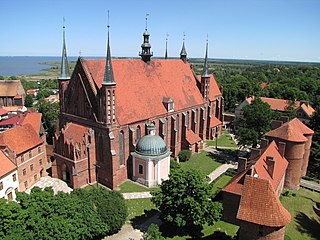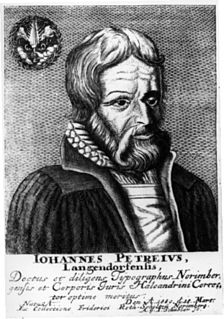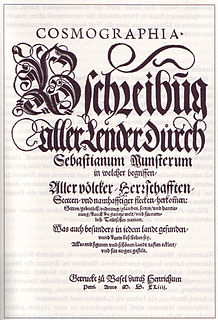The Nicolaus-Copernicus-Gesamtausgabe (Nicolaus Copernicus Complete Edition) is a comprehensive, commented collection of works by, about, and related to Nicolaus Copernicus. The Gesamtausgabe includes Copernicus's surviving manuscripts and notes, his published writings, other authors' commentary about Copernicus and his works, a bibliography, and a biography.

Nicolaus Copernicus was a Renaissance-era mathematician and astronomer who formulated a model of the universe that placed the Sun rather than the Earth at the center of the universe, in all likelihood independently of Aristarchus of Samos, who had formulated such a model some eighteen centuries earlier.
Compilation of the series began in 1973 to commemorate the 500th anniversary of Copernicus's birth. The first volume is the astronomer's landmark work, De revolutionibus orbium coelestium (On the Revolutions of the Heavenly Spheres), which expounded Copernicus's heliocentric theory of the universe. The set is published by Akademie Verlag in Berlin, Germany.

An astronomer is a scientist in the field of astronomy who focuses their studies on a specific question or field outside the scope of Earth. They observe astronomical objects such as stars, planets, moons, comets, and galaxies – in either observational or theoretical astronomy. Examples of topics or fields astronomers study include planetary science, solar astronomy, the origin or evolution of stars, or the formation of galaxies. Related but distinct subjects like physical cosmology, which studies the Universe as a whole.

De revolutionibus orbium coelestium is the seminal work on the heliocentric theory of the astronomer Nicolaus Copernicus (1473–1543) of the Polish Renaissance. The book, first printed in 1543 in Nuremberg, Holy Roman Empire, offered an alternative model of the universe to Ptolemy's geocentric system, which had been widely accepted since ancient times.

Copernican heliocentrism is the name given to the astronomical model developed by Nicolaus Copernicus and published in 1543. It positioned the Sun near the center of the Universe, motionless, with Earth and the other planets orbiting around it in circular paths modified by epicycles and at uniform speeds. The Copernican model displaced the geocentric model of Ptolemy that had prevailed for centuries, placing Earth at the center of the Universe. It is often regarded as the launching point to modern astronomy and the Scientific Revolution.
This page is based on this
Wikipedia article Text is available under the
CC BY-SA 4.0 license; additional terms may apply.
Images, videos and audio are available under their respective licenses.
Georg Joachim de Porris, also known as Rheticus, was a mathematician, astronomer, cartographer, navigational-instrument maker, medical practitioner, and teacher. He is perhaps best known for his trigonometric tables and as Nicolaus Copernicus's sole pupil. He facilitated the publication of his master's De revolutionibus orbium coelestium.

Frombork is a town in northern Poland, on the Vistula Lagoon, in Braniewo County, Warmian-Masurian Voivodeship. It had a population of 2,528 as of 2005.
Domenico Maria Novara (1454–1504) was an Italian scientist.
The year 1543 in science and technology marks the beginning of the European Scientific revolution and included many events, some of which are listed here.
The year 1506 in science and technology included many events, some of which are listed here.
Trepidation, in now-obsolete medieval theories of astronomy, refers to hypothetical oscillation in the precession of the equinoxes. The theory was popular from the 9th to the 16th centuries.

Johann(es) Petreius was a German printer in Nuremberg.

De libris revolutionum Copernici narratio prima, usually referred to as Narratio Prima, is an abstract of Nicolaus Copernicus' heliocentric theory, written by Georg Joachim Rheticus in 1540. It is an introduction to Copernicus's major work, De revolutionibus orbium coelestium, published in 1543, largely due to Rheticus's instigation. Narratio Prima is the first printed publication of Copernicus's theory.

Conversations on the Plurality of Worlds is a popular science book by French author Bernard le Bovier de Fontenelle, published in 1686. It offered an explanation of the heliocentric model of the Universe, suggested by Nicolaus Copernicus in his 1543 work De revolutionibus orbium coelestium. The book is Fontenelle's most famous work and is considered to be one of the first major works of the Age of Enlightenment.

The Prutenic Tables, were an ephemeris by the astronomer Erasmus Reinhold published in 1551. They are sometimes called the Prussian Tables after Albert I, Duke of Prussia, who supported Reinhold and financed the printing. Reinhold calculated this new set of astronomical tables based on Nicolaus Copernicus' De revolutionibus orbium coelestium, the epochal exposition of Copernican heliocentrism published in 1543. Throughout his explanatory canons, Reinhold used as his paradigm the position of Saturn at the birth of the Duke, on 17 May 1490. With these tables, Reinhold intended to replace the Alfonsine Tables; he added redundant tables to his new tables so that compilers of almanacs familiar with the older Alfonsine Tables could perform all the steps in an analogous manner.

Henricus Petrus (1508–1579) and his son Sebastian Henric Petri headed the printer shop of Basel, called Officina Henricpetrina.
Franz Rhode was a German printer of the 16th century.
Akademie Verlag is a German scientific and academic publishing company, founded in 1946 in the Soviet-occupied eastern part of divided Berlin to facilitate the publication of works by and for the German Academy of Sciences Berlin.

Nicolaus Mulerius was a professor of medicine and mathematics at the University of Groningen.
David Origanus or David Tost was a German astronomer and professor for Greek language and Mathematics at the Viadrina University in Frankfurt (Oder), where he had also studied.

Hieronymus Schreiber, also called Jerôme Schreiber, was a German doctor, mathematician and astronomer from Nuremberg.
The year 1512 in science and technology included a number of events, some of which are listed here.

Jean-Pierre Verdet is a French astronomer, historian of astronomy and mathematician.













